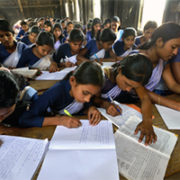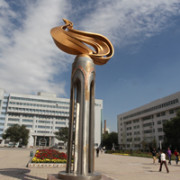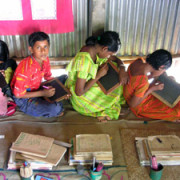Tag Archives | Education
Education, Information and Communications Technology, Poverty, Social development and protection
 Education, Gender, Sanitation
Education, Gender, Sanitation
 Capacity development, Education, Information and Communications Technology, Social development and protection
Capacity development, Education, Information and Communications Technology, Social development and protection
 Energy
Energy
 Economics, Education, Governance and public sector management, Poverty
Economics, Education, Governance and public sector management, Poverty
 Economics, Education
Economics, Education
 Education
Education
 Education
Education

Income inequality, educational outcomes, and digital infrastructure: Can public–private partnerships play a pivotal role in Asia and the Pacific?

Addressing inequality requires a new strategy in today’s modern age. Policy makers in Asia and the Pacific need to tackle a new form of inequality—the digital divide.
Does sanitation access improve schooling outcomes for girls and boys?

All the sanitation improvement projects and investments over the years beg the question of whether we have seen a significant increase in school enrollment and gender parity in education or not. While most empirical studies on sanitation focus on the relationship between sanitation and health, recent studies have now looked into the downstream impacts of sanitation on other development indicators, such as those related with education and gender.
T20 and realizing education for all in the Digital Age

Education is a key driver for sustainable development (UNESCO 2018). However, the goal of realizing education for all in the Digital Age faces two major challenges. First, many countries and economies are still not ensuring quality education for all. Millions of children and youth still lack the necessary tools to realize their potential amid economic, political, and social strife. Second, with the emergence of the fourth Industrial Revolution and the growing use of automation, big data, and artificial intelligence, human labor is being substituted increasingly by machines or algorithms.
Do solar lights help kids do better in school?

Rural areas of Asia and Africa where children lack access to high-quality educational opportunities tend to also be energy poor. Solar lanterns and other small solar energy products, commonly termed “picoPVs”, have been promoted as a promising first step toward improving both lighting in homes and educational outcomes. Rural households throughout Asia and Africa have bought over 100 million picoPVs since 2010, with India, Bangladesh, and other South Asian markets being among the most “vibrant” (and receiving significant market development support from governments and development agencies).
Why is Income Distributed Unequally? A Comparison of Japan and the United States

Japan and the United States (US) are at similar levels of economic development, yet their income distributions are considerably different. Whereas Japan has a relatively equal income distribution, the US is marked by a high level of income inequality. What are the sources of income inequality in both countries? Our latest research aims to uncover the sources on income inequality in both countries by exploiting detailed household panel survey.
Benefits of education and training for SMEs in Asia

The importance of small and medium-sized enterprises (SMEs) to economies in Asia is well known. They account for over 95% of all businesses, a third to half of aggregate output, and the majority of enterprise employment (Vandenberg, Chantapacdepong, and Yoshino 2016). We also know that SMEs do not have an easy life. They struggle to get established, face a higher failure rate than large firms, and lack access to key inputs such as finance. Finding ways to increase their survival rate and growth is important for expanding private sector activity in Asia’s developing economies. Sustaining enterprises requires that they are competitive; competitiveness, in turn, is based on productivity.
Asia: The next higher education superpower?

In most higher education discourse today it is not unusual to hear the claim that the world’s center of gravity is shifting toward the East. Indeed, no region has undergone as profound a transformation as Asia during the past half-century, from the 1970s to the present. Unprecedented economic growth has driven major social and demographic change and institutional reform and, in most countries, has brought about greater stability. The advent of a large middle class, coupled with openness and market reforms driven by economic imperatives, has contributed to greater interconnectedness among Asian states and between them and the rest of the world.
Learning crisis in South Asia

South Asia is home to a growing youth population and widely considered to benefit from the “demographic dividend” in the coming decades. The United Nations Population Fund’s State of World Population 2014 report The Power of 1.8 Billion: Adolescents, Youth and the Transformation of the Future therefore calls for increased investment in youths and adolescents.


Search
Subscribe / Connect to Asia Pathways
Subjects
- Agriculture and natural resources
- Blog
- Capacity development
- Climate change
- Economics
- Education
- Energy
- Environment
- Finance sector development
- Gender
- Governance and public sector management
- Health
- Industry and trade
- Information and Communications Technology
- Infrastructure
- Miscellaneous
- Population
- Poverty
- Private sector development
- Regional cooperation and integration
- Sanitation
- Social development and protection
- Transport
- Uncategorized
- Urban development
- Video Blog
- Water
Recent Posts
- Unraveling the Health Risks of Climate Change
- Linking Farmers to Markets Through Agricultural Cooperatives and E-Commerce in Asia
- How Can Governments Support Electricity Distribution to Achieve Net Zero in Asia?
- Promoting Corporate Climate Action Through Greenhouse Gas Accounting
- Evaluating G7 Commitments on Climate Change, Health, Well-Being, and Agriculture




Recent Comments